Fine and Decorative Arts at Auction
February 14th, 2014
|
U.S. House of Representatives chair attributed to Bembe and Kimbel, New York, circa 1857, oak, three-star Federal shield surrounded by oak leaves carved on the upper crest, original black leather upholstery, original finish, 40¼" high, $18,000.
A match race at Newmarket by Francis Sartorius I (English, 1734-1804), oil on canvas, 18¾" x 31¾", $22,800.
Off the Rocks at Camp Nelson by Paul Sawyier (1865-1917), watercolor on paper, signed, 13" x 19½" (sight size), $14,400.
Noah’s ark in pine with painted details, having 350 decorated wood and gesso animals and insects, ark 14" high x 29¼" long, $9225. |
|
|
|
Two-part secretary bookcase, possibly Maryland or Kentucky, 1790-1800, cherry with barber-pole and chevron line inlays, desk compartment featuring shield-breasted eagle inlay, 90" high x 40½" wide, Museum of Early Southern Decorative Arts label, $12,000.
Patriotic silver presentation water pitcher by Gorham, Providence, Rhode Island, circa 1864, attached ornaments include an eagle, Lady Liberty, and American flags, 11½" high, $9000.
Apple Pickers in Penn., by Charles Wysocki (1928-2002), oil on canvas, signed, 30" x 40" (sight size) plus frame, $10,800.
Agra rug, India, early 20th century, 27'6" x 15', $9225.
|
Cowan’s Auctions, Cincinnati, Ohio
Photos courtesy Cowan’s
The market was as flashy as it was fickle during the fine and decorative arts sale held February 14 and 15 at Cowan’s Auctions in Cincinnati, Ohio, where about 1150 lots grossed $811,000. Artwork dominated much of the auction, with one painting bringing the top price and another the biggest disappointment.
Leading all the bidding was an 18th-century British painting by Francis Sartorius the Elder of a match race at Newmarket; it sold for $22,800 (including buyer’s premium), slightly above the high estimate. The 18¾" x 31¾" oil on canvas included one rider wearing the colors of the Earls Fitzwilliam. The Sartorius family was among the leading equine artists in England, painting horses, horse races, and hunting scenes. For collectors, the appeal is international.
“It’s the subject matter that’s interesting to them,” said Graydon Sikes, Cowan’s director of paintings and prints. Sikes described the work as a fabulous painting with great provenance. It sold to a buyer in Minnesota, underbid by someone in Kentucky, where horseracing is practically a religion.
As good as the Sartorius painting was, even higher expectations were pinned to a Russian landscape, Engadine in Snow, by Ivan Fedorovich Choultsé (Russian, 1874-1939). Showing a cabin by a body of water with mountains in the background, the 21" x 25" (sight size) work was estimated at $80,000/120,000 but failed to make its reserve.
“The Russian art market has come back quite a bit, but I don’t think it’s come back that much,” said Sikes. “The art was probably the most spotty section of the sale,” he added. Nevertheless, there were pockets of strong interest along the way.
Regional art led the American works when Off the Rocks at Camp Nelson, a 13" x 19½" (sight size) watercolor on paper by Paul Sawyier, sold above estimate for $14,400 to a Kentucky buyer.
Cowan’s offered two oil paintings by Charles Wysocki. Apple Pickers in Penn., 30" x 40" (sight size), sold for $10,800, and Winter - New England, 30" x 36" (sight size), realized $9600. Cowan’s has offered a handful of Wysocki’s works before. “These two are the best we’ve ever had,” noted Sikes.
Also selling within estimate was The Spring House by Eric Sloane. The 17½" x 19½" (sight size) oil on board depicting several stone structures went at $9225.
Not that everything was rainbows and kittens. At times the art market clearly showed a downward shift from years past. An 1880 courting scene of a couple in a garden by Jules Garnier (French, 1847-1889), oil on canvas, 29¾" x 18" (sight size), brought only $4800 against an estimate of $8000/12,000. According to Sikes, the painting had been purchased in the early 1990s for $9500. “The market for European art has softened,” he said. “You really have to have something spectacular.”
Provenance continues to influence sales. “People are becoming more and more concerned with ownership history,” Sikes said. “They like to see something has been exhibited.…It’s becoming a much bigger factor than it used to be.”
Despite some of the bumps along the way, Sikes was pleased with the results. “All in all, I thought the sale was great,” he said.
Diane Wachs, Cowan’s director of decorative arts, was also happy with her side of the sale. “There were pockets that I wanted to do backflips over. I had someone on a phone bid for five or six lots of silver. She was obviously a dealer, and she didn’t get a single lot.…We are so relieved that people are buying silver now, not for its weight value but for its aesthetic value.”
The prize piece was a Samuel Kirk coin silver water pitcher that sold for $10,455 against an estimate of $600/800. Made in Baltimore between 1828 and 1846, the pitcher had a cast leaf-capped handle, a spout with a bearded mask, and repoussé decoration of flowers, shells, and a merman.
A silver presentation water pitcher made by Gorham, Providence, Rhode Island, had an inscription dated 1864 and realized $9000 (est. $4000/6000). Wildly patriotic, the pitcher had attached ornaments that included an eagle with a shield and an American flag over rifles and swords, a shield with a helmet and various weapons, and a figure of Lady Liberty with an American flag. The pitcher was given to Stephen H. Burton, a prominent Cincinnati and Ohio politician, by Miles Greenwood, Burton’s partner in a highly successful ironworks business.
Although the provenance didn’t hurt, bidding for the pitcher was greatly influenced by its design. “It’s not necessarily the history people who are buying them,” Wachs explained. “When you had a piece that was so extraordinary as the piece with applied figures to it, it was the whole package.”
When it comes to silver, anything by Tiffany or Georg Jensen is still desirable, as are some specialty areas, according to Wachs. “The market for presentation and agricultural pieces, especially southern ones, has never abated,” she said.
For mundane examples, however, that’s not the case. Silver flatware in common designs turns few heads. “Certain twentieth-century patterns are selling for melt, and most of those we don’t take,” she added.
Folk art continued its steady march across the marketplace with a circa 1880 sand bottle by Andrew Clemens selling for $19,800, well above its estimate. One side of the design was lettered “Presented By Matt To His Aunt Elen [sic]” over flowers, while the other side pictured an eagle in flight with an American flag, all over a geometric border.
Other folk art included a 29¼" long Noah’s ark in pine with painted details, accompanied by 350 decorated wood and gesso animals and insects. Bidding went to $9225. Wachs thought the price should have been higher. “That was a bargain for someone,” she said. “Overall, it was extraordinary.”
Historical items included a U.S. House of Representatives chair attributed to Bembe and Kimbel, New York, circa 1857, that went over estimate at $18,000. The heavily carved oak chair included a design of a three-star Federal shield surrounded by oak leaves.
The catalog noted: “This chair was designed by Thomas Ustick Walter, the United States Capitol Architect, for an 1857 renovation and expansion of the United States House of Representatives, and was likely created by New York furniture company Bembe and Kimbel. In 1859 photographers Mathew Brady and Alexander Gardner purchased these chairs for use in their studios and produced many photographs of political dignitaries in the chairs, including a famed Brady portrait of Lincoln reading to his son Tad. The chairs remained in use in the House of Representatives until 1873 when the chamber was again refurbished. At that time the chairs were gifted or sold to members of Congress.”
Wachs said a combination of factors affected the price of the chair. “It’s supply and demand and history,” she noted. “We’ve sold them in better condition than this. That seems to be a small factor; that’s fixable. Provenance and makers—you can’t change that.”
Also finding strong demand was a 90" tall two-piece secretary bookcase in cherry with barber-pole and chevron line inlays and an interior inlay of a shield-breasted eagle. Possibly made in Maryland or Kentucky, 1790-1800, it realized $12,000 (est. $2500/5000). Adding value to the secretary was a 1975 label from the Museum of Early Southern Decorative Arts (MESDA).
“The guy that got it really felt like he got a deal, and I do too,” said Wachs. The MESDA label was of prime importance. “It’s absolutely as good as Tiffany.”
As a whole, brown furniture did well. “We had quite a bit of English furniture in this sale that was taken care of. It wasn’t the finest English furniture out there, but we’re calling it the Downton Abbey effect. English furniture in this sale really rocked.” Chairs and tilt-top tables brought steady bidding.
The biggest mystery of the auction might have been its strangest item, a Luman Watson tall-case clock set into a small server. The 92" high mahogany clock with wooden works had ebony columns on the bonnet, fan inlay above the door, and a painted dial lettered “L. Watson, Cincinnati, Ohio,” and it was set into a 30¾" wide serpentine-front mahogany, maple, and cherry server. Estimated at $4000/6000, it sold for $2760. For Wachs, the price was disappointing.
Bidders clearly had their doubts about the piece. “Everyone thought it was a bastardization,” she said. Wachs, however, wasn’t so easily convinced, noting at that least one other example is known to exist.
She believes that the clock/server combo offered by Cowan’s was made by Watson in Cincinnati. The clock case and the server featured mahogany veneer, and the catalog dated it to 1815-20. “I just found it to be phenomenal,” she said. “People either loved it or hated it. Buyers were afraid of it, I think.”
For more information, contact Cowan’s at (513) 871-1670; Web site (www.cowans.com).
Originally published in the May 2014 issue of Maine Antique Digest. © 2014 Maine Antique Digest






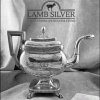



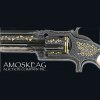









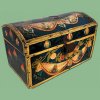






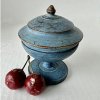


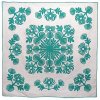

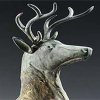
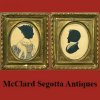


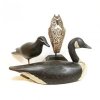




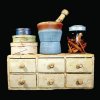







 Samuel Kirk coin silver water pitcher, Baltimore, 1828-46, cast leaf-capped handle, spout with bearded mask, and repoussé decoration of flowers, shells, and a merman, marked, 12¾" high, $10,455.
Samuel Kirk coin silver water pitcher, Baltimore, 1828-46, cast leaf-capped handle, spout with bearded mask, and repoussé decoration of flowers, shells, and a merman, marked, 12¾" high, $10,455.



 Andrew Clemens (1857-1894) sand bottle, circa 1880, one side showing an eagle in flight with a 37-star American flag, the other side lettered “Presented By Matt To His Aunt Elen [sic]” over flowers, geometric borders, 7" high, $19,800.
Andrew Clemens (1857-1894) sand bottle, circa 1880, one side showing an eagle in flight with a 37-star American flag, the other side lettered “Presented By Matt To His Aunt Elen [sic]” over flowers, geometric borders, 7" high, $19,800.








